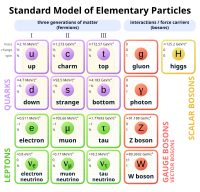
Photo from wikipedia
Background: The study of low-energy neutrinos and their interactions with atomic nuclei is crucial to several open problems in physics, including the neutrino mass hierarchy, CP violation, candidates of physics… Click to show full abstract
Background: The study of low-energy neutrinos and their interactions with atomic nuclei is crucial to several open problems in physics, including the neutrino mass hierarchy, CP violation, candidates of physics beyond the standard model, and supernova dynamics. Examples of experiments include CAPTAIN at the Spallation Neutrino Source (SNS) as well as DUNE's planned detection program of supernova neutrinos. Purpose: We present cross section calculations for charged current and neutral current neutrino-nucleus scattering at low energies, with a focus on Ar-40. We also take a close look at pion decay-at-rest neutrino spectra, which are used in e.g. the SNS experiment at Oakridge. Methods: We employ a Hartree-Fock + continuum random phase approximation (HF + CRPA) framework, which allows us to model the responses and include the effects of long-range correlations. It is expected to provide a good framework to calculate forbidden transitions, whose contribution we show to be non-negligible. Results: Our results for a Fe-56 nucleus compare favorably to others models. Calculations performed for a Ar-40 target shows that the cross section contributions by 1(-) and 2(-) transitions in the continuum channels are nontrivial for the energies considered. Conclusions: Forbidden transitions can be expected to contribute sizeably to the reaction strength at typical low-energy kinematics. Modeling and Monte Carlo simulations need to take all due care to account for the influence of their contributions.
Journal Title: Physical Review C
Year Published: 2019
Link to full text (if available)
Share on Social Media: Sign Up to like & get
recommendations!